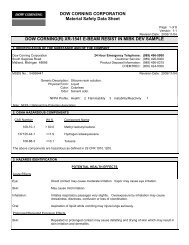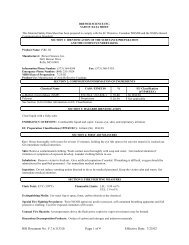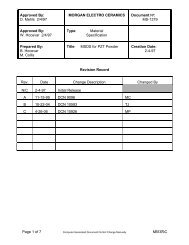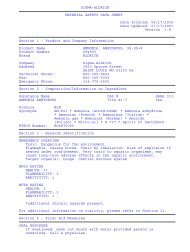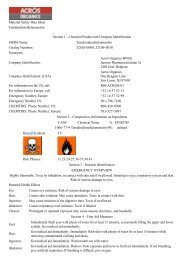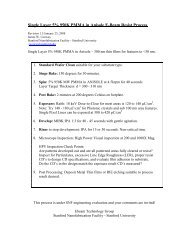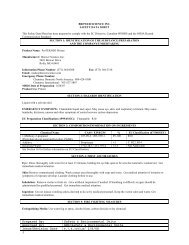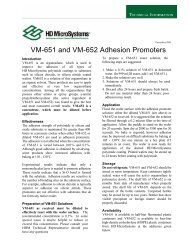MSDS M10 - Stanford Nanofabrication Facility
MSDS M10 - Stanford Nanofabrication Facility
MSDS M10 - Stanford Nanofabrication Facility
You also want an ePaper? Increase the reach of your titles
YUMPU automatically turns print PDFs into web optimized ePapers that Google loves.
Beryllium Solid <strong>MSDS</strong> No. <strong>M10</strong> January 1, 2010<br />
all personnel prior to respirator use. Users of tight fitting respirators must be clean shaven on those areas of<br />
the face where the respirator seal contacts the face. Exposure to unknown concentrations of particulate<br />
requires the wearing of a pressure-demand airline respirator or pressure-demand self-contained breathing<br />
apparatus (SCBA). Use pressure-demand airline respirators when performing jobs with high potential<br />
exposures such as changing filters in a baghouse air cleaning device.<br />
8.5 OTHER PROTECTIVE EQUIPMENT<br />
Protective overgarments or work clothing must be worn by persons who may become contaminated with<br />
particulate during activities such as machining, furnace rebuilding, air cleaning equipment filter changes,<br />
maintenance, furnace tending, etc. Contaminated work clothing and overgarments must be managed in a<br />
controlled manner to prevent secondary exposure to workers of third parties, to prevent the spread of<br />
particulate to other areas, and to prevent particulate from being taken home by workers.<br />
8.6 PROTECTIVE GLOVES<br />
Wear gloves to prevent contact with particulate or solutions. Wear gloves to prevent metal cuts and skin<br />
abrasions during handling.<br />
8.7 EYE PROTECTION<br />
Wear safety glasses, goggles, face shield, or welder’s helmet when risk of eye injury is present, particularly<br />
during melting, casting, machining, grinding, welding, powder handling, etc.<br />
8.8 HOUSEKEEPING<br />
Use vacuum and wet cleaning methods for particulate removal from surfaces. Be certain to de-energize<br />
electrical systems, as necessary, before beginning wet cleaning. Use vacuum cleaners with high efficiency<br />
particulate air (HEPA). Do not use compressed air, brooms, or conventional vacuum cleaners to remove<br />
particulate from surfaces as this activity can result in elevated exposures to airborne particulate. Follow the<br />
manufacturer’s instructions when performing maintenance on HEPA filtered vacuums used to clean hazardous<br />
materials.<br />
8.9 MAINTENANCE<br />
During repair or maintenance activities the potential exists for exposures to particulate in excess of the<br />
occupational standards. Under these circumstances, protecting workers can require the use of specific work<br />
practices or procedures involving the combined use of ventilation, wet and vacuum cleaning methods,<br />
respiratory protection, decontamination, special protective clothing, and when necessary, restricted work<br />
zones.<br />
8.10 WELDING<br />
In accordance with OSHA regulation 29 CFR 1910.252 welding of materials containing beryllium is regulated<br />
as follows: Welding or cutting indoors, outdoors, or in confined spaces involving beryllium containing base or<br />
filler metals shall be done using local exhaust ventilation and pressure-demand airline respirators unless<br />
atmospheric tests under the most adverse conditions have established that the workers’ exposure is within the<br />
acceptable concentrations defined by 29 CFR 1910.1000. In all cases, workers in the immediate vicinity of the<br />
welding or cutting operations shall be protected as necessary by local exhaust ventilation or airline respirators.<br />
8.11 CORROSION PROTECTION<br />
Beryllium is corrosion-resistant in air and water up to 600°C. This is attributed to the formation of an adherent<br />
oxide layer on the surface.<br />
Page 6 of 11



